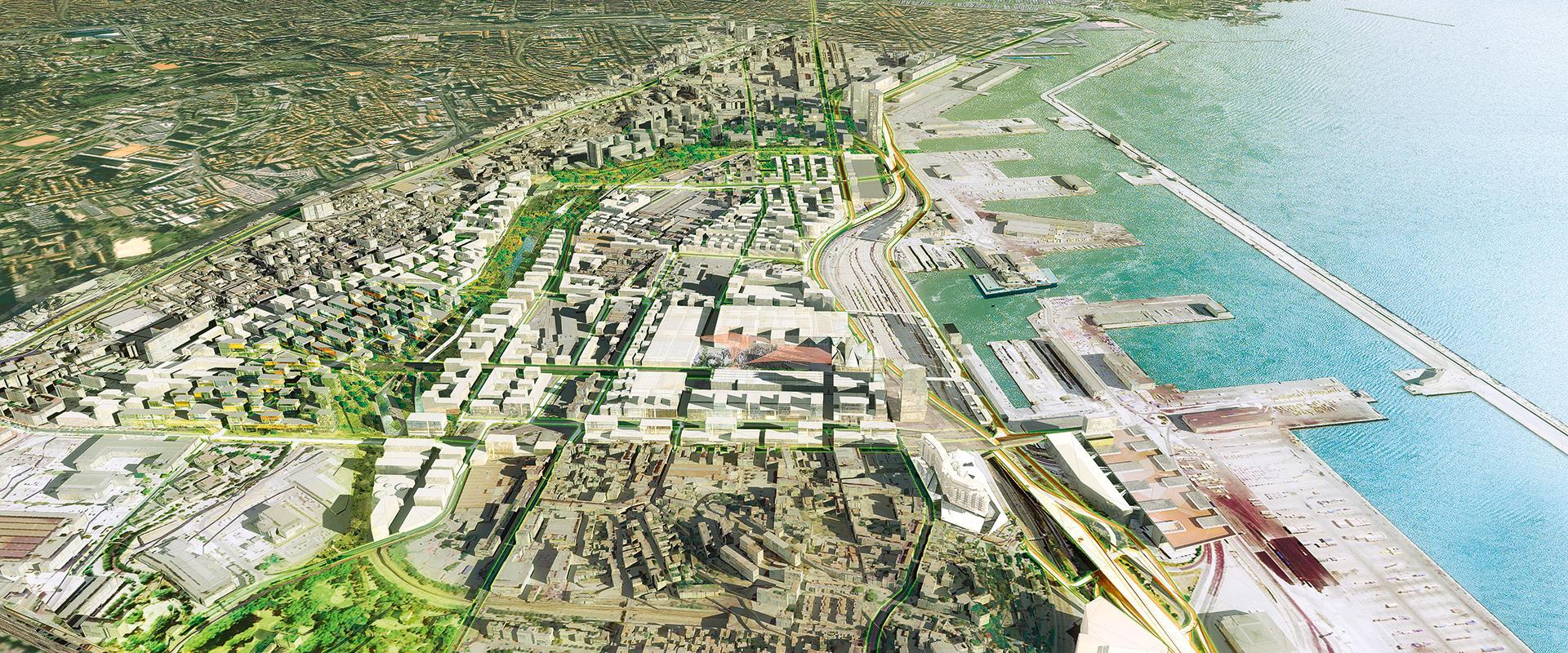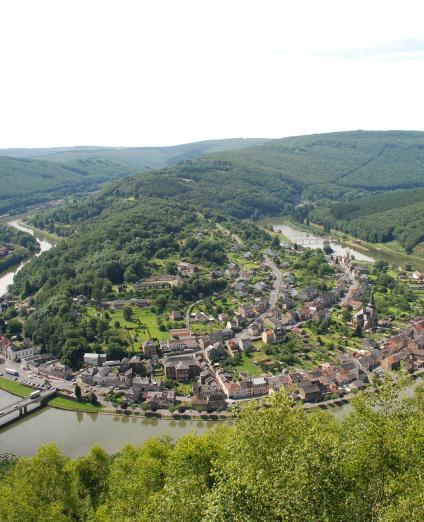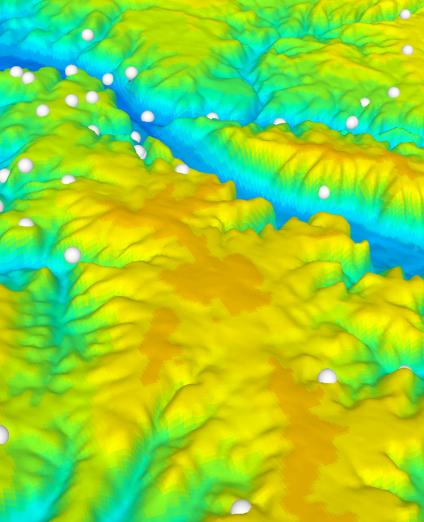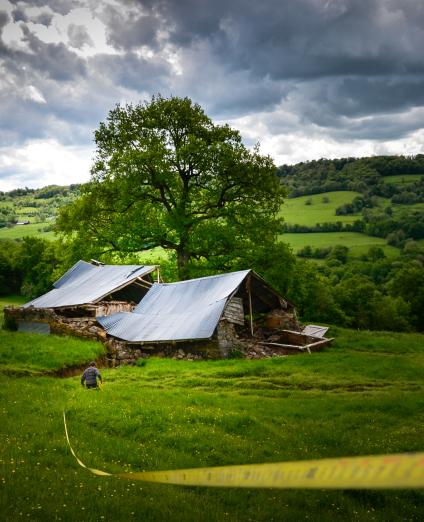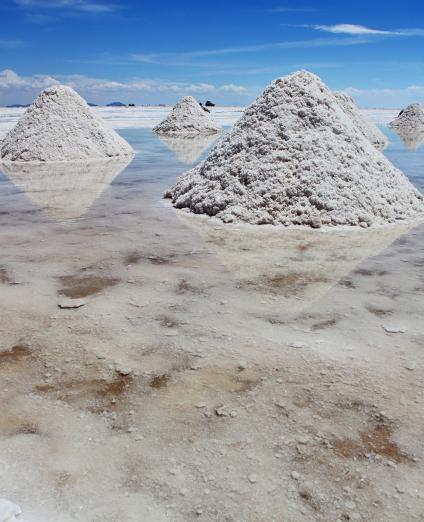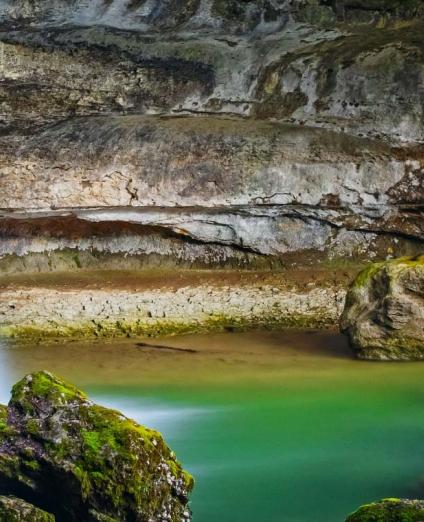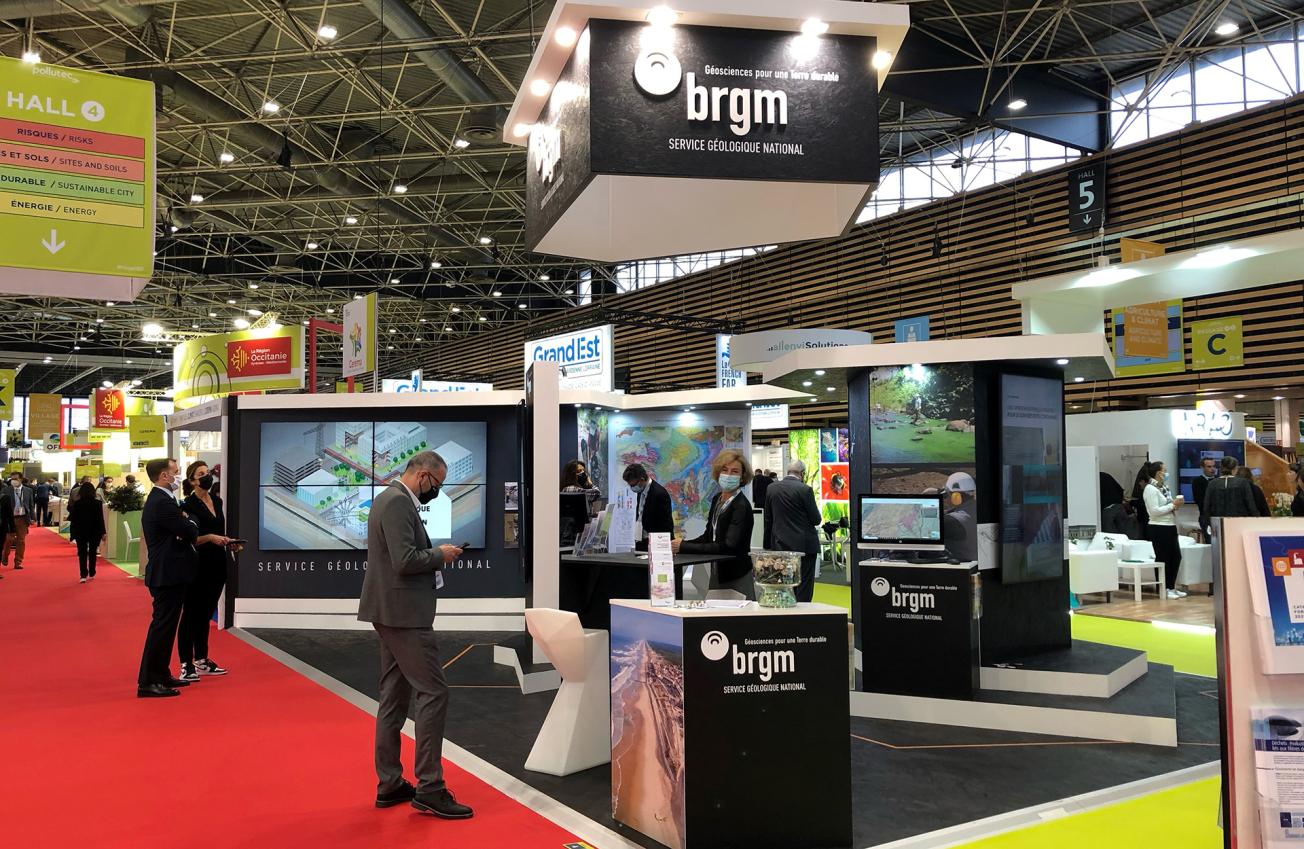
BRGM stand at Pollutec 2021 (Lyon, 2021).
© BRGM - Frédéric Moreira
The meeting place for environmental innovation
The Pollutec trade fair is known to be the most important event for environmental professionals. It is also a showcase for environmental solutions for industry, cities and regions, and a springboard for market innovations and international development.
Pollutec is:
- 2,200 exhibitors
- 400 conferences
- 70,000 professionals
- 128 countries
BRGM, an expertise in water, waste, circular economy, polluted sites, geothermal energy
On its stand 4-K94, BRGM will be presenting its offer in the fields of ecotechnologies, renewable energies, waste treatment, water management and polluted sites on its stand.
BRGM participation in presentations and round tables
BRGM is hosting and participating in 15 presentations and round tables at various forums, including the Pollutec forum. Read more about our participation below.
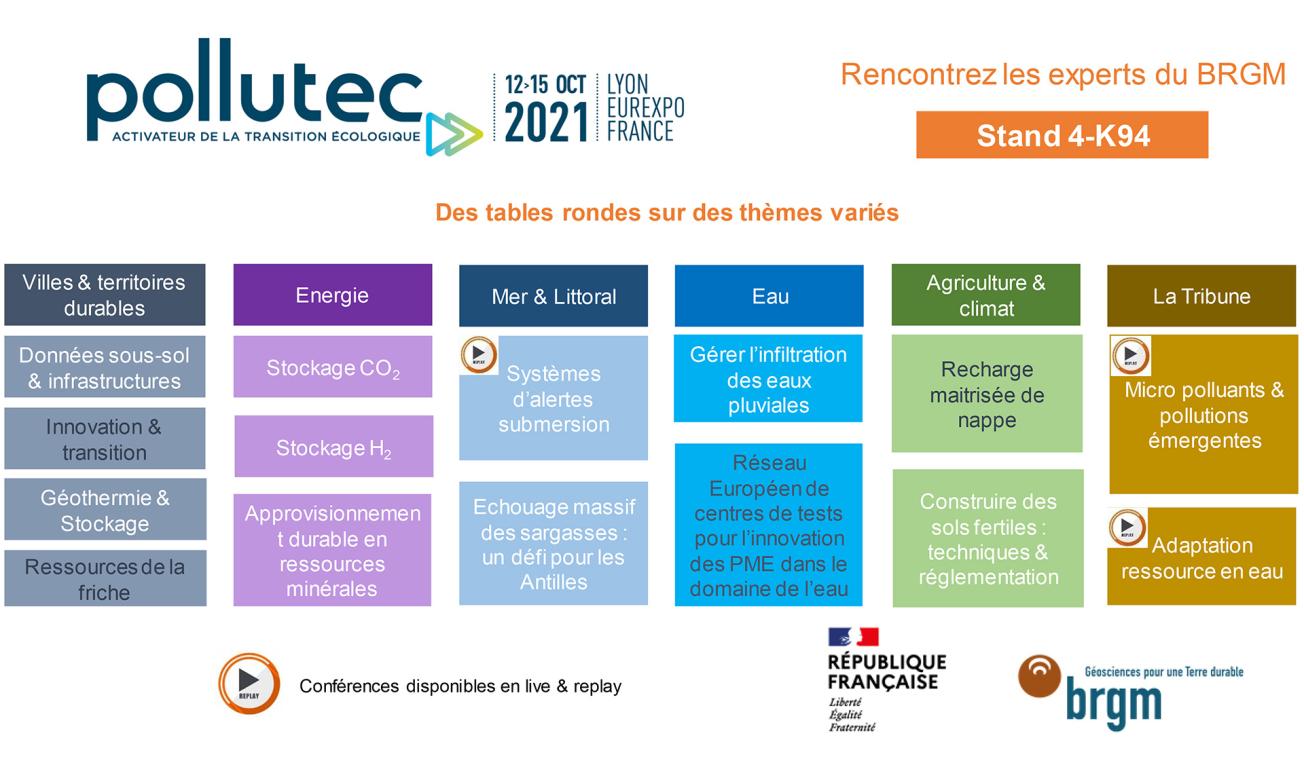
BRGM conference programme at Pollutec 2021.
© BRGM
Anticipate the environmental and economic challenges of innovations serving transitions
“Sustainable city and territory” forum - Tuesday 12 October, 10.25 a.m.-11.10 a.m.
Cities and regions are moving towards more sustainable, less carbon-intensive and more circular economies. They call on innovative solutions, original value chains that need to be developed and tested. Beyond the technical and market success of these projects, the progress made and the potential obstacles to environmental and economic aspects can be anticipated and quantified by the assessment tools used during the research and testing phase. Life Cycle Analysis (LCA), technico-economic studies, material flow analysis or Material Flow Analysis (MFA) or even multi-criteria evaluations are examples of these tools.
This round table brings together several representatives of teams working on the development and implementation of these tools during research projects serving innovative solutions and new value chains. They will be at your disposal to clarify the interest of these tools and share their experience of projects serving more sustainable cities and territories.
Participation of BRGM
How to make subsoil data available for infrastructure management?
“Sustainable city and territory” forum – Tuesday 12 October, 12.15 p.m.–1 p.m.
The BRGM, French Geological Survey, produces, collects and disseminates geoscience data with high stakes and impact for the different sectors of construction, infrastructure and industry (project owners, project managers, contractors, industrialists). The purpose of this round table is therefore to present the possible interactions between its various actors and the BRGM through concrete projects and achievements on the themes of water, risks or energy. It will be organized in 3 stages with a first part devoted to the methods, tools and services made available by the BRGM to consume its data, a second focused on the current use by manufacturers of BRGM data and a third more prospective part on the current BRGM projects aimed at facilitating even more the valorization of its data in the production chain of these different actors.
Conference organised by BRGM
Capture, store or use CO2 to reduce emissions from industrial facilities and territories
“Energy” forum – Tuesday 12 October, 4.50 p.m.–5.35 p.m.
In response to the urgency of climate change mitigation, there is growing interest worldwide in CO2 Capture, Storage and Utilisation technology (CCUS). It is the geological carbon sink, which consists of returning carbon to the subsurface from which it was extracted in order to reduce the unavoidable residual CO2 emissions from industrial facilities and to remove CO2 from the atmosphere (‘negative emissions’). Complementary to the terrestrial (soil and forest) and oceanic carbon sinks, it is expected to play a key role in achieving carbon neutrality. Synergies with the development of hydrogen and renewable energies (geothermal, biomass, energy storage) are possible. Some twenty CCUS projects are already in operation around the world. France is getting ready.
Conference organised by BRGM
Optimization and development of geothermal processes: thermal storage
“Sustainable city and territory” forum – Wednesday 13 October, 10.25 a.m.–11.10 a.m.
The use of geothermal energy as seasonal storage (hot and cold) to increase its efficiency and accelerate its development is a promising avenue, for example by smoothing the production of a solar thermal power plant, the heat produced in summer being reused in winter. The underground can be a particularly suitable space for storing a large amount of heat for a long time. With heat exchangers inserted into the roadway, EUROVIA has designed and developed the Power-Road© technology, which recovers the heat from the solar radiation absorbed by the pavements of roads and car parks, and allows it to be reused for the heating of installations such as swimming pools, urban or commercial centres, heat networks...
EUROVIA has partnered with BRGM to evaluate the technical and economical feasibility of coupling the Power-Road© with an underground heat storage solution, and to establish a mapping of "favorability" depending on the local characteristics of the underground (geology, hydrogeology, ...) and the main characteristics of the project on the surface.
Conference organised by BRGM
Managing rainwater in an urban environment differently - Using the subsoil properties to infiltrate and reuse them
“Water and Sanitation” forum – Wednesday 13 October, 10.25 a.m.–11.10 a.m.
This theme is of increasing interest to regionals authorities and finds its full meaning in the perspective of climate change and the securing of water resources. Its deployment, which must better consider the urbanized area and its watershed, comes up against some technical obstacles such as the influence of the quality of the soils (of their pollution) on the quality of the water reaching the groundwater. , the suitability of soil infiltration, the construction of collection networks and storage basins, the interactions between rainwater management, wastewater treatment and management of upwelling groundwater.
Conference organised by BRGM
Massive strandings of sargassum, a challenge for the West Indies
“Sea and coastline” forum: Wednesday 13 October, 2.05 p.m.–2.50 p.m.
The massive stranding of Sargassum (Sargassum natans and S. fluitans) since 2011 on the West Indian coasts has serious consequences from an environmental point of view (asphyxiation of marine fauna and flora), economic (oxidation of electronic devices, technical unemployment for companies located near the shore, decline in tourism, etc.) and health (toxic fumes of hydrogen sulphide and ammonia during their decomposition, possible exposure to Arsenic and Chlordecone). Various study projects carried out in Guadeloupe, Martinique and Orléans have made it possible to understand the dynamics of stranding, the contamination of the environmental environment linked to these bioaccumulative algae as well as the possible degradation processes.
Conference organised by BRGM
Resources from brownfields
“Sustainable city and territory” forum – Wednesday 13 October, 2.05 p.m.–2.50 p.m.
Brownfields and circular economy are closely linked. A brownfield is a place that can provide a number of resources that can be used for its own redevelopment, for the renovation of another site or for the development of new activities.
We invite you to come and discover the wealth of brownfields, presented by regional stakeholders.
Participation of BRGM
Controlled groundwater recharge, a solution to be tested - API Workshop
“Agriculture and Climate” forum – Wednesday 13 October, 3.30 p.m.–4.15 p.m.
Conference co-organised with Agriculture Périurbaine Innovante.
Participation of BRGM
HYGEO - A project to develop hydrogen storage in a saline cavity in the New Aquitaine region
“Energy” forum – Wednesday 13 October, 3.55 p.m.–4.40 p.m.
Massive energy storage, allowing the integration of intermittent renewable energies into the electricity mix, is one of the components of the energy transition. This massive storage requires large volumes of storage. HYGEO aims to develop a geological energy storage using so-called "green" hydrogen, obtained by electrolysis of water without greenhouse gas emissions, and stored in an abandoned geological cavity such as those used for the storage of hydrocarbons.The feasibility study concerns a site located in Nouvelle-Aquitaine (capacity of this cavity to store hydrogen, economic relevance, environmental and societal aspects, operating methods involved by the new uses of hydrogen).
Conference organised by BRGM
What solutions to adapt water resources to climate change?
“Pollutec” forum – Thursday 14 October, 10.15 a.m.–11.30 a.m.
Great Debate: Groundwater recharge - What exactly is the situation? Climate forecasts estimate that recharge levels will fall by 10 to 30% by 2070.
Climate change and its impacts put the issue of water use and the sustainable management of this resource at the heart of the news. Nature-based solutions, hill reservoirs, artificial groundwater recharge, rainwater storage… many solutions exist but each one must be chosen according to water usages and characteristics of each territory.
BRGM participation in the Pollutec forum
Potentials and limits of recycling in a sustainable supply of mineral resources and industrial sovereignthy strategy
“Energy” forum – Thursday 14 October, 12.15 a.m.–1 p.m.
World might face metal supply shortage because of an increasing demand driven by the energy and the digital transitions and by an increase of the world population. In such a context, the circular economy concept needs to be developed and encouraged and the industry supply chains need to be secured, responsible and sustainable. Recycling is one of the solution and its potential is most probably still underestimated and underused, and specifically for certain type of metals (strategic and critical). Nevertheless, recycling also faces some constraints and some limitations, such as the thermodynamic barrier for metal recovery because of the dispersion of metals in complex matrix. New recycling strategies might not necessary include a production of pure metals.
Conference organised by BRGM
Micropollutants and emerging pollution types: how can we measure their impact and what are the solutions?
“Pollutec” forum – Thursday 14 October, 3.30 p.m.–4.45 p.m.
- Initial analysis of the 2016–2021 Micropollutants Plan to preserve water quality and biodiversity
- What are the results of the national ECOPHYTO pesticide reduction plans?
- Introducing the objectives and methodologies of forthcoming plans
BRGM participation in the Pollutec forum
Perspectives and innovation in submersion warning system approaches
“Sea and coastline” forum – Thursday 14 October, 3.55 p.m.–4.40 p.m.
The objective is to discuss current and near future developments in the performance of the submersion warning systems proposed to coastal municipalities.
Due to the importance of its seafront and its low coasts, France is particularly exposed to the risk of marine submersion. Today, France has 1.4 million inhabitants and 850,000 jobs exposed to marine submersions according to the Preliminary Flood Risk Assessment (EPRI).
Following the Lothar and Martin storms of 1999, Météofrance, at the request of the state, set up a national procedure for informing the population, called "Vigilance Vague Submersion", VVS, which completes the spoils of Meteo France. The purpose of this procedure is to provide the national public authorities at the departmental level with the means of anticipation, by an earlier announcement, of a major crisis.
If the departmental VVS represents a rapid and effective level of information, its variation and its use to anticipate the events of submersion on the scale of a site or a municipality remains a major stake for the services of the State and the local collectives. The obstacles to achieving this are both technological (model physics, uncertainties, calculation time) and sociological (what information for which actor and in what format?). Various steps are underway to improve and complete the service currently provided, currently innovative solutions for the prevention and warning of coastal submersion from the sub-departmental to local scale.
On the basis of the example carried around the Arcachon basin, the actors present at the round table will draw the technological advances that must meet these challenges and their level of maturity. They will discuss the short- and medium-term perspectives that these will allow, in response to actors on the ground in their decision-making in relation to an announced storm event: public authorities, state and community services, civil security.
Conference organised by BRGM
A network used by SMES in North-West Europe (NWE) to test, demonstrate and develop new products for the water sector
“Water and Sanitation” forum – Thursday 14 October, 3.55 p.m.–4.40 p.m.
The Water Test Network (WTN) project has established a transnational network of testing facilities which can be used by SMEs in North-West Europe (NWE) to test, demonstrate and develop new products for the water sector. In this way, new innovations will be developed and it will accelerate the time to market.
In a competitive global water market, pre-commercial testing is difficult and costly at operational scale and investors are reluctant to invest in unproven technology. This way it can take 15-20 years to bring new technology to the market. To increase market opportunities in this fast growing sector, WTN helps SMEs from across NWE to test their innovative water technologies at Technology Readiness Level (TRL) 5-8. This is achieved by creating a transnational network of operational scale demonstrator sites in UK, FR, DE, NL and BE, which will offer a range of water types, clean and waste water, in rural and urban settings, for specialist applications such as pharma or agricultural.
By working closely with SMEs, offering them an integrated package of support and linking them to the best possible site for their needs, validation and commercialisation of near to market water solutions will be accelerated, providing an investor ready pipeline of new products and processes.
During this conference we will take you into the world of WTN. We show you what has been achieved and what is possible for you as an SME!
Participation of BRGM
Building fertile soils: technical and regulatory advances
“Agriculture and climate” forum – Thursday 14 October, 4.50 p.m.–5.35 p.m.
Soil is an essential part of ecosystems. In addition to its function as a support for vegetation, it is involved in the carbon, nitrogen and water cycles, making it a key element in the fight against the effects of climate change. It has therefore become essential to try to restore it, where it has been degraded or even destroyed, in order to give back to artificial surfaces the functions specific to fertile soils, seats of an intense biological activity and capable of sequestering carbon in the long term. All these functions are of interest to planners who want to develop cities that are pleasant to live in and resilient to global change. For nearly 15 years, the idea of using the many abandoned wastes of the city to rebuild these soils has been gaining ground. This round table will clarify the field of possibilities by presenting the latest technical and regulatory advances in the field.
Conference organised by BRGM

